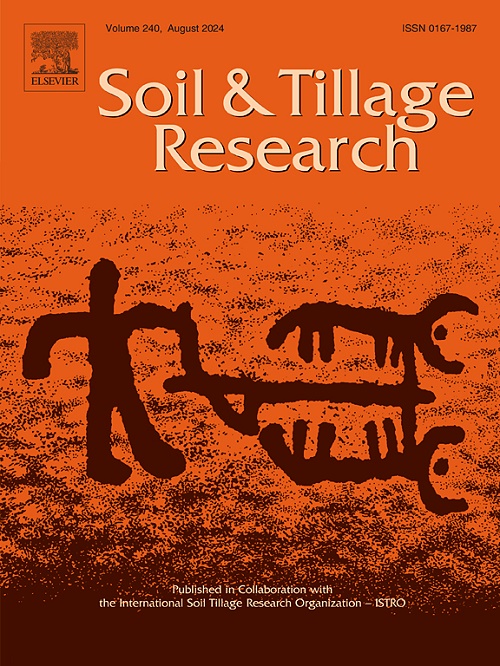覆盖种植改变微生物生活史策略,通过土壤代谢物介导果园系统中坏死块碳积累
IF 6.1
1区 农林科学
Q1 SOIL SCIENCE
引用次数: 0
摘要
初步研究表明,覆盖作物增加了土壤坏死体碳(C)的积累,但微生物生活史策略与土壤生化途径之间的具体机制尚不清楚。本研究对中国南方毛杨覆盖下果园系统的这些过程进行了研究,重点研究了生物标志物分析对坏死物C的量化,并研究了微生物组合、生活史策略和土壤代谢物对坏死物C的贡献。与清洁耕作(CT)相比,清洁耕作(CT)增加了33.90 %,土壤有机碳(SOC)增加了27.36 %。CC还增强了同质选择(HS),与CT相比,细菌群落组装率提高了12.85 %,加强了确定性过程。此外,CC将微生物生活史策略转向y策略,丰富了某些具有强大生长潜力的变形菌,导致其相对丰度增加40.87 %。脂质和核酸代谢途径的代谢物,包括脂质和脂质样分子(LL)以及核苷、核苷酸和类似物(NN),在CC下显著增强,相对丰度分别增加了94.85 %和27.73 %,并与坏死团C呈正相关。偏最小二乘路径模型表明,CC改变了细菌群落组成,最终增加了坏死团C含量。这种效应主要由土壤代谢物介导。综上所述,这些发现表明CC通过HS促进y -战略家优势,HS调节LL和NN代谢,促进坏死团C积累。本研究揭示了果园生态系统中微生物介导的生物化学过程控制坏死物C动力学的新视角,为可持续农业管理提供了实际意义。本文章由计算机程序翻译,如有差异,请以英文原文为准。
Cover cropping shifts microbial life-history strategies to promote necromass carbon accumulation through soil metabolite mediation in orchard systems
Preliminary studies suggest that cover cropping (CC) enhances necromass carbon (C) accumulation, but the specific mechanisms linking microbial life-history strategies and soil biochemical pathways remain unclear. This study investigated these processes in orchard systems under hairy vetch (Vicia villosa Roth) cover in southern China, focusing on quantifying necromass C using biomarker analysis and examining the contributions of microbial assembly, life-history strategies, and soil metabolites to necromass C. Compared to clean tillage (CT), CC increased necromass C by 33.90 % and soil organic carbon (SOC) by 27.36 %. CC also enhanced homogeneous selection (HS), boosting bacterial community assembly by 12.85 % compared to CT, reinforcing deterministic processes. Additionally, CC shifted microbial life-history strategies toward the Y-strategy, enriching certain Proteobacteria with strong growth potential, leading to a 40.87 % increase in their relative abundance. Metabolites from the lipid and nucleic acid metabolic pathways, including lipids and lipid-like molecules (LL) as well as nucleosides, nucleotides, and analogues (NN), were significantly enhanced under CC, with relative abundances increasing by 94.85 % and 27.73 %, respectively, and positively correlating with necromass C. Partial least squares path modeling indicated that CC altered the bacterial community composition, ultimately increasing necromass C content, with this effect primarily mediated by soil metabolites. Overall, these findings demonstrate that CC promotes Y-strategist dominance through HS, which regulates LL and NN metabolism to promote necromass C accumulation. This study reveals novel perspectives on the microbial-mediated biochemical processes governing necromass C dynamics in orchard ecosystems, offering practical implications for sustainable agricultural management.
求助全文
通过发布文献求助,成功后即可免费获取论文全文。
去求助
来源期刊

Soil & Tillage Research
农林科学-土壤科学
CiteScore
13.00
自引率
6.20%
发文量
266
审稿时长
5 months
期刊介绍:
Soil & Tillage Research examines the physical, chemical and biological changes in the soil caused by tillage and field traffic. Manuscripts will be considered on aspects of soil science, physics, technology, mechanization and applied engineering for a sustainable balance among productivity, environmental quality and profitability. The following are examples of suitable topics within the scope of the journal of Soil and Tillage Research:
The agricultural and biosystems engineering associated with tillage (including no-tillage, reduced-tillage and direct drilling), irrigation and drainage, crops and crop rotations, fertilization, rehabilitation of mine spoils and processes used to modify soils. Soil change effects on establishment and yield of crops, growth of plants and roots, structure and erosion of soil, cycling of carbon and nutrients, greenhouse gas emissions, leaching, runoff and other processes that affect environmental quality. Characterization or modeling of tillage and field traffic responses, soil, climate, or topographic effects, soil deformation processes, tillage tools, traction devices, energy requirements, economics, surface and subsurface water quality effects, tillage effects on weed, pest and disease control, and their interactions.
 求助内容:
求助内容: 应助结果提醒方式:
应助结果提醒方式:


